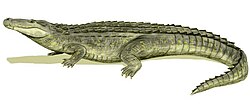Paleobiology
The strata from which remains of Piscogavialis have been found suggest that it lived in a coastal environment. [5] [6] Another extinct marine gavialid, Sacacosuchus , was described in 2022 and discovered in the same formation. Sacacosuchus was smaller, estimated to be up to 4.32 m (14.2 ft) long, whereas Piscogavialis was nearly double the size. [4]
During the Miocene, what is now the Pisco Basin in Peru was largely covered by a shallow marine transgression that connected to the open ocean. The environment was marked by shallow waters, protected bays with rocky shores and small islands. The south-east Pacific coast was inhabited by at least two species of crocodilians, Piscogavialis and Sacacosuchus, throughout most of this time period. The remains of both species were found alongside other animals typical for the marine environments of this region including various cetaceans, seals, seabirds, marine sloths and sharks. As the Peruvian sediments yielded bones of both adults and juvenile specimens, it is assumed that Sacacosuchus spent its entire life in saltwater. Although Piscogavialis was notably larger, it was also likely more specialized, feeding primarily on fast fish. Sacacosuchus, meanwhile, in spite of being only half the length of its contemporary relative, was adapted to a more generalist diet. [4]
During the Miocene, environmental factors worked together to highly favor marine gavialoids, in particular warm temperatures and abundant shallow water coastal environments suited to their lifestyle. Subsequently, their diversity was high during most of this time period with their range extending as far south as Chile. However, despite these initially favorable conditions, global temperatures continuously dropped throughout the late Neogene. Initially, both Piscogavialis and Sacacosuchus weren't heavily affected, with the water temperatures of their habitat continuing to support these ectotherms until at least the end of the Miocene period. Eventually, however, the extinction of Peru's marine gavialids was brought on by the disruption of these coastal ecosystems, caused by dropping sea levels and the uplifting of the Andes Mountains, coupled with the more drastically dropping global temperatures of the Pliocene. [4]
This page is based on this
Wikipedia article Text is available under the
CC BY-SA 4.0 license; additional terms may apply.
Images, videos and audio are available under their respective licenses.



